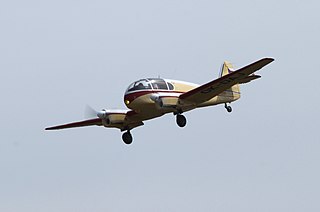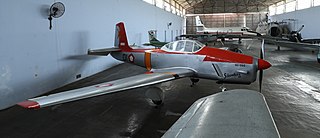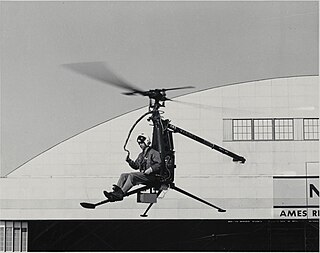
The Saab 91 Safir is a three or four seater, single engine trainer aircraft. The Safir was built by Saab AB in Linköping, Sweden and by De Schelde in Dordrecht, Netherlands.

The PZL TS-8 Bies (Devil) is a Polish trainer aircraft, used from 1957 to the 1970s by the Polish Air Force and civilian aviation.

The Aero 45 was a twin piston-engined civil utility aircraft produced in Czechoslovakia after World War II. Aero Vodochody produced the aircraft in 1947–1951, after which the Let Kunovice rolled out these planes until 1961. In 1958 the Ae-45S became the first Czechoslovak plane to cross the Atlantic Ocean. It was the first product of the nation's postwar aviation industry and proved a great success, with many of the 590 produced being exported.

The Scottish Aviation Twin Pioneer was a British STOL transport aircraft built by Scottish Aviation Limited at Prestwick Airport, Scotland, during the 1950s. It was designed for both civil and military operators. It was conceived as a twin-engined version of the Pioneer light transport. Both aircraft required "an area only 30m (99ft) by 275m (902ft) in which to operate."

The Aero L-60 Brigadýr was a small, high-wing propeller-driven Czechoslovakian STOL utility aircraft developed for both civil and military use. A prototype, designated XL-60, with Argus As 10C engine, first flew on December 24, 1953, but it was not successful. The plane was thoroughly redesigned and the second improved prototype, with M-208B flat-six engine, flew on June 8, 1954. The aircraft's configuration bears a strong resemblance to the Fieseler Fi 156 "Storch" licence-produced in Czechoslovakia during and after World War II, and which this aircraft was intended to replace. By the end of production in 1960, 273 had been built by Aero, including an improved version, the L-160 with an all-metal tail.

The Cessna 310 is an American four-to-six-seat, low-wing, twin-engine monoplane produced by Cessna between 1954 and 1980. It was the second twin-engine aircraft that Cessna put into production; the first was the Cessna T-50. It was used by the U.S. military as the L-27, after 1962, U-3. Over six thousand Cessna 310 and 320 aircraft were produced between 1954 and 1980.

The Aérospatiale N 262 is a French twin-turboprop high-wing airliner built first by Nord Aviation. The aircraft was also known as the Nord 262.

The Nord Aviation 3202 is a 1950s French military trainer aircraft designed and built by Nord Aviation to meet a French Army requirement for a two-seat basic trainer, as a replacement for the biplane Stampe SV.4. Altogether, 101 examples were built, with the first flying on 17 April 1957.

The LIPNUR Sikumbang was a low-wing monoplane of mixed construction built in Indonesia in 1954 as a COIN and anti-guerrilla-warfare aircraft. Of conventional configuration, it had fixed tricycle undercarriage and seated the pilot under a bubble canopy. A single example was built under the designation NU-200 in 1954, and another as the NU-225 in 1957. The latter machine was grounded in 1967.

The LIPNUR Belalang was a military trainer aircraft built in small numbers in Indonesia by LIPNUR in the late 1950s. It was essentially a Piper L-4J Grasshopper converted to give it a low wing. The NU-85 prototype flew for the first time on 17 April 1958 and the first production of NU-90 took place in 1959. The aircraft was operated by Indonesian Air Force. Indonesian Army and Indonesian Civil Aviation Institute at Curug, Tangerang also used this aircraft.
LIPNUR developed and manufactured the Super Kunang - also known as the Super Kunang 35 - in the 1960s. Powered by a Volkswagen air-cooled engine and seating only one person, it was used as a light sports plane.

The Piaggio P.166 is an Italian twin-engine pusher-type utility aircraft developed by Piaggio Aero. The aircraft model name was Portofino, and is also known as Albatross in South African military service.
The Boisavia B.260 Anjou was a four-seat twin-engine light aircraft developed in France in the 1950s. It was a low-wing cantilever monoplane of conventional configuration with retractable tricycle undercarriage. Intended by Boisavia as a touring aircraft, it did not find a market and only the single prototype was constructed. At this point, the firm sold the design to SIPA, which modified the design and re-engined it with Lycoming O-360 engines, but found that they could not sell it either. At a time when the twin-engine light plane market was already dominated by all-metal American aircraft, the Anjou's fabric-over-tube construction was something of an anachronism, and all development was soon ceased. Plans to develop a stretched version with three extra seats and Potez 4D engines were also abandoned.

The Nesmith Cougar is a light aircraft that was developed in the United States in the 1950s and marketed for homebuilding.

The Fletcher FD-25 Defender was a light ground-attack aircraft developed in the United States in the early 1950s.
The Partenavia P.59 Jolly was an Italian two-seat training monoplane designed by Partenavia to meet a requirement for the Aero Club d'Italia. First fight was in 1960.
The THK-5 was a twin-engine aircraft designed by Stanisław Rogalski and built in Turkey in 1945 as an air ambulance. It was a conventional, low-wing cantilever monoplane of wooden construction throughout. The main units of the tailwheel undercarriage retracted into the wing-mounted engine nacelles and the THK-5 could carry two stretcher cases plus a medical attendant. This was followed in production by a six-seat utility transport version designated THK-5A and three examples of an improved version of the 5A designated THK-10. A single example of the type was exported, sold to Denmark.

The Hiller ROE Rotorcycle is a single-seat ultralight helicopter designed in 1953 for a military requirement. A total of 12 were produced for the United States Marine Corps. And in 1954, the Hiller Helicopters was selected by the US Navy's Bureau of Aeronautics to build this design of a one-man, foldable, self-rescue and observation helicopter. It featured a two-blade rotor system. Its original empty weight was 290 lb (132 kg).

The Scheibe SF-23 Sperling (en:Sparrow) is a 1950s German two-seat cabin monoplane.

The Jodel DR1050 Excellence and Ambassadeur are part of a family of French built aircraft, designed by Jean Délémontez in collaboration with Pierre Robin, as a development of the Jodel D.10 project. The aircraft was built from 1958 to 1967 both by Centre-Est Aeronautique (CEA) and by Société Aéronautique Normande (SAN) but since the demise of the latter in 1968 has only been supplied as plans.

















